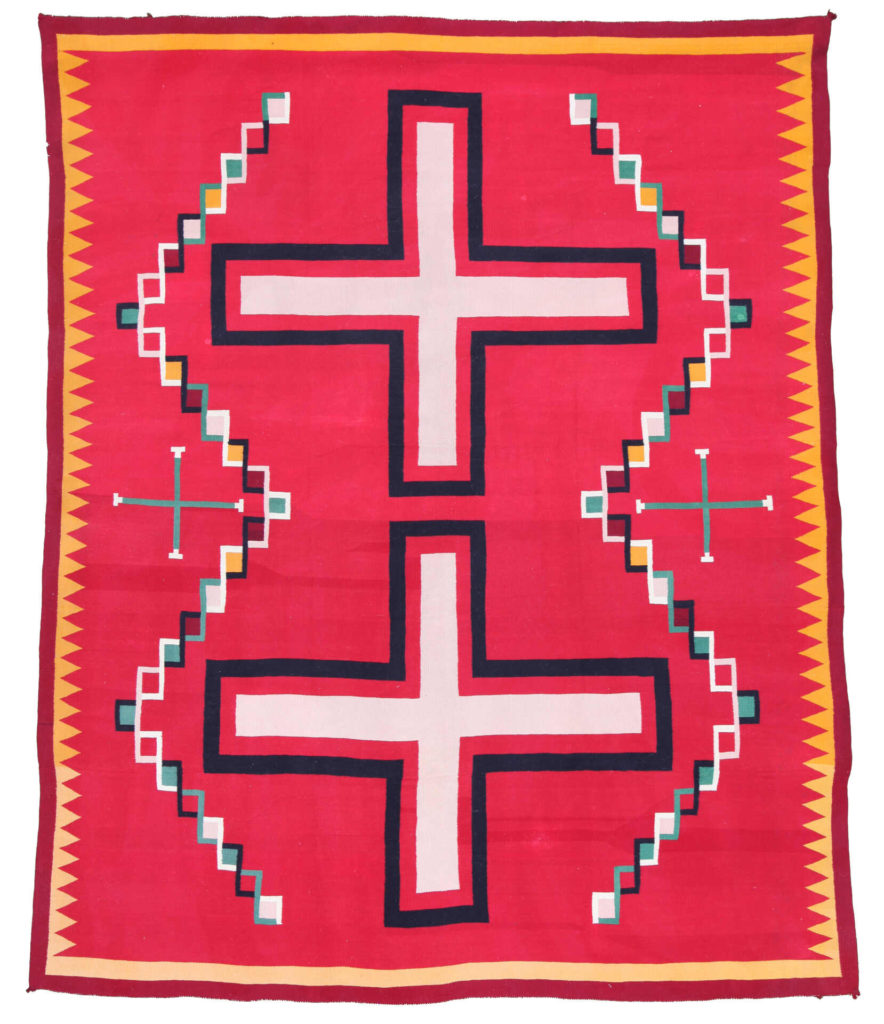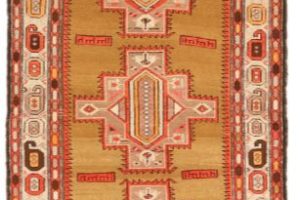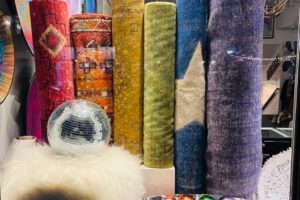By: David Neishabori

Navajo rugs are shrouded in legends. The Native American tribe teaches that a goddess named Spider Woman instructed the people on weaving. The first loom was fashioned from the sky and earth cords were made from sunlight, crystal, and white shells. Although the story is lovely, historians believe that the Navajo people learned weaving from their Pueblo neighbors.
Cotton Farming for Rug and Blanket Weaving
Throughout the region of northern New Mexico, the Pueblo people started to grow cotton in 1300 AD. They used cotton to weave a multitude of items. Initially, they used only finger weaving, but they eventually adopted the backstrap loom that was common with tribes from the south. Movies regularly depict women as weaving, but historically, the weavers have been the men.
Navajo Learn to Weave
When the Spaniards came to the region, they brought Churro sheep with them, so cotton became outdated and everything was woven from wool. At this time, around 1600, the Navajo also started using the Pueblo weaving techniques. Blue made from indigo dye and simple striped patterns were adopted.

Navajo Women Weavers
As the region became more settled with Spaniards and Europeans, the Navajo men ceased weaving and it became a skill of the women. The men would build the elaborate looms and the women would weave lovely blankets. The Dine Community College undertook a huge study in 1973 to determine the hours it took to weave a blanket. Their conclusion was that a single blanket required 345 hours, which was two weeks of work.
Overall, the time breakdown was as follows:
- Sheep shearing – 45 hours
- Spinning the wool – 24 hours
- Preparing and dying the wool – 60 hours
- Weaving – 215 hours
- Selling – 1 hour
Types of Navajo Blankets
The Navajo developed three types of blankets that were common:
- Saddle blanket
- Chief’s blanket
- Serape blanket (a type of shoulder blanket)
Turning from Blankets to Rugs
The nation of the Navajo was made up of family settlements. Many traders encouraged the women of the tribe to start weaving so they could market their creations throughout the Victorian east. It was at this time that the Navajo slowed at weaving blankets and turned their focus to rugs. The desire for Navajo rugs has never abated. The rugs are showpieces around the world.
The Demand for Navajo Rugs
Around the 1870s, with the widespread reach of the railroad, the demand for Navajo rugs on the East coast of the US and in Europe reached a peak. The demand was so high that the traders started to pay for the rugs and blankets only by the pound. Unfortunately, this made the Navajos work quickly to make money so quality started to slip. They also started to practice deceitful acts to increase the weight. They would scour the wool to increase the poundage of the piece. Many even added clay to the rug’s fibers to make it weigh more. Unfortunately, the word of the low-quality blankets and rugs quickly spread on the east coast and the market started to dry up.
The Decline of the Navajo Rugs and Blankets
Another factor that caused the decline in the rug quality was that the Rambouillet sheep provided by the US government for the Navajo people produced low-quality wool. In addition, the Pendleton Woolen Mills in Oregon flooded the market with cheaper blankets that featured the Navajo motifs.
The Changing Rugs
Local trading posts were forced to run quality control and think of new ways to market the Navajo rugs. One of the ways they turned to was to have local artists make rug designs that the Navajo weavers would then copy and modify. At this time, black borders and geometric designs became popular. A mail-order catalog was also made to appeal to buyers from all locations.
A Resurgence of the Rugs’ Popularity
From the 1920s to the 1940s, the Navajo rugs again became immensely popular. The US government even focused on helping the Navajo overcome the problem wool by bringing in different sheep. They established The Navajo Breeding Laboratory to breed a better type of sheep to meet the needs of the Navajo weavers.
The demand for Navajo rugs has never abated. Many homes around the world feature the lovely Southwestern designs.

Visit AZADI Fine Rugs to view our extensive collection of Navajo Rugs. In addition, AZADI has over 40,000 rugs in styles ranging from Antique to Contemporary.
Established in 1790, AZADI Fine Rugs is your most trusted resource for Fine Contemporary & Antique Rugs. For over two-centuries, AZADI Fine Rugs has been honored to share history, art, and culture through the magic of handwoven rugs. With an inventory of over 40,000 in-stock fine rugs, and Galleries in Scottsdale, Sedona, Telluride, and Jackson Hole, AZADI has given the most refined clients and Interior Designers in the world an unforgettable experience with an unparalleled selection of fine quality contemporary and antique rugs.
At AZADI Fine Rugs it isn’t just about running a successful business… it’s about a deep commitment to the communities we serve and Weaving a Brighter Future for Humanity. AZADI is a major philanthropic supporter of local, national, and global charities; including St. Mary’s Food Bank, Sedona Community Food Bank, Teton Youth & Family Services, Telluride Angel Baskets, Phoenix Art Museum, and The Heart Ball, and the National Museum of Wildlife Art, just to name a few. Recently AZADI donated $100,000 to the Telluride Science Research Center for the global effort in finding a vaccine for COVID-19.
Call today to begin your unforgettable shopping experience.
Visit AZADI Fine Rugs in the following locations: (AZ, CO, WY, and by appointment… anywhere in the U.S.A.)
AZADI Fine Rugs In Scottsdale: (480) 483-4600
AZADI Fine Rugs In Sedona: (928) 203-0400
AZADI Fine Rugs In Jackson Hole (307) 734-0169
AZADI Fine Rugs In Telluride: (970) 728-4620
AZADI Navajo Rugs in Sedona: (928) 203-0620





